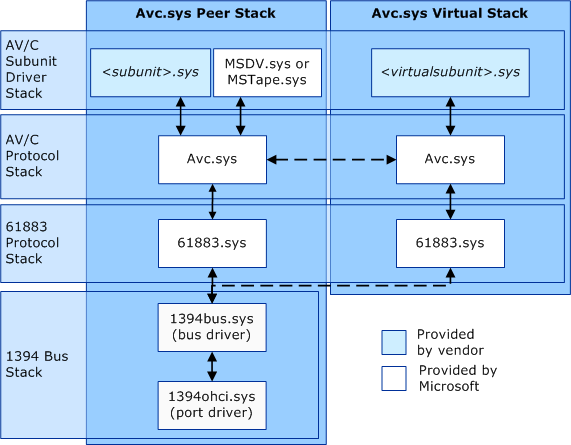AV/C Driver Stacks
As AV/C devices are added to and removed from the IEEE 1394 bus, the Plug and Play manager loads and unloads the corresponding subunit drivers. Vendors implement unique AV/C subunit functionality by writing a subunit driver that Windows loads onto the IEEE 1394 stack above Avc.sys. Avc.sys uses functionality provided by the underlying IEEE 1394 and IEC-61883 drivers to control devices and to connect and manage plugs. For more information about these underlying driver stacks, see The IEEE 1394 Driver Stack and IEC-61883 Client Drivers.
The peer driver stack is for subunits on external AV/C devices. In contrast, the virtual driver stack is a separate driver stack that exposes the computer as an AV/C device to other AV/C devices that are connected on the IEEE 1394 bus. The following diagram demonstrates the two different Avc.sys stacks.

At the base of the driver stacks are 1394ohci.sys and 1394bus.sys. These drivers provide the basic IEEE 1394 bus infrastructure support. There are instances of these drivers for each physical IEEE 1394 adapter in the system.
Stacked above 1394ohci.sys and 1394bus.sys is 61883.sys. There is an instance of 61883.sys for each IEC-61883-enabled node on the IEEE 1394 bus. The driver's 61883.sys provides the following support for the IEC 61883 protocol:
Connection Management Protocol (CMP) IEC 61883-1
Common Isochronous Packet (CIP) IEC 61883-1
Function Control Protocol (FCP) IEC 61883-1
Stacked above 61883.sys is Avc.sys, which supports the AV/C protocol, the Plug and Play enumeration of active subunits on each AV/C device, and AV/C subunit plug connection management and control. For more information about plug connection and format management, see AV/C Subunit Plug Connection and Format Management.
Subunit drivers are stacked above Avc.sys. This is the layer where vendors implement the functionality that is unique to their AV/C subunit. Generally, for every physical instance of an AV/C subunit, there is a corresponding instance of that subunit's driver. That is, each device identifier (ID) is represented by an instance of Avc.sys. However, Avc.sys permits this behavior to be overridden based on the Vendor and/or Model fields of the device identifier of the AV/C unit. For more information about the Vendor, Model, SubunitType, and SubunitID fields of device identifier strings generated by Avc.sys see AV/C Device IDs.
Feedback
Coming soon: Throughout 2024 we will be phasing out GitHub Issues as the feedback mechanism for content and replacing it with a new feedback system. For more information see: https://aka.ms/ContentUserFeedback.
Submit and view feedback for